
A Resource Hub for participants, instructors and field advisors participating in Core for Social Workers in Northern California.
- Subject:
- Arts and Humanities
- Career and Technical Education
- Social Science
- Material Type:
- Reading
- Date Added:
- 12/14/2016

A Resource Hub for participants, instructors and field advisors participating in Core for Social Workers in Northern California.

In this deep dive session, Dr. Willa van Dijk discusses how transparency with data, materials, and code is beneficial for educational research and education researchers. She illustrates these points by sharing experiences with transparency that were crucial to her success. She then shifts gears to provide tips and tricks for planning a new research project with transparency in mind, including attention to potential pitfalls, and also discusses adapting materials from previous projects to share.

In this deep dive session, Amanda Montoya (UCLA) and Karen Rambo-Hernandez (Texas A&M University) introduce the basics of preregistration and Registered Reports: two methods for creating a permanent record of a research plan prior to conducting data collection. They discuss the conceptual similarities and practical differences between pre-registration and registered reports. They provide practical advice from their own experiences using these practices in research labs and resources available for researchers interested in using these approaches. The session concludes with questions and discussion about adopting these practices and unique considerations for implementing these practices in education research.
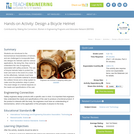
Students are introduced to the biomechanical characteristics of helmets, and are challenged to incorporate them into designs for helmets used for various applications. By doing this, they come to understand the role of enginering associated with saftey products. The use of bicycle helmets helps to protect the brain and neck in the event of a crash. To do this effectively, helmets must have some sort of crushable material to absorb the collision forces and a strap system to make sure the protection stays in place. The exact design of a helmet depends on the needs and specifications of the user.
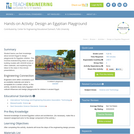
Student teams use their knowledge about ancient Egypt to design playgrounds for Egyptian children. This involves brainstorming ideas on paper, building models with LEGO® bricks or other materials, and explaining their ideas to the class in five-minute presentations.

The course considers the growing popularity of sustainability and its implications for the practice of engineering, particularly for the built environment. Two particular methodologies are featured: life cycle assessment (LCA) and Leadership in Energy and Environmental Design (LEED). The fundamentals of each approach will be presented. Specific topics covered include water and wastewater management, energy use, material selection, and construction.

In this video segment adapted from ZOOM, cast members design and build door alarms using a variety of materials, including aluminum foil, batteries, and buzzers.

In this video segment adapted from ZOOM, cast members discover that metal is a good conductor of electricity as they play the steadiness tester game.
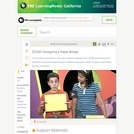
In this video segment adapted from ZOOM, cast members make a bridge from a single piece of paper. Will it be strong enough to hold a hundred pennies?

Sharing data and code are important components of reproducible research. Data sharing in research is widely discussed in the literature; however, there are no well-established evidence-based incentives that reward data sharing, nor randomized studies that demonstrate the effectiveness of data sharing policies at increasing data sharing. A simple incentive, such as an Open Data Badge, might provide the change needed to increase data sharing in health and medical research. This study was a parallel group randomized controlled trial (protocol registration: doi:10.17605/OSF.IO/PXWZQ) with two groups, control and intervention, with 80 research articles published in BMJ Open per group, with a total of 160 research articles. The intervention group received an email offer for an Open Data Badge if they shared their data along with their final publication and the control group received an email with no offer of a badge if they shared their data with their final publication. The primary outcome was the data sharing rate. Badges did not noticeably motivate researchers who published in BMJ Open to share their data; the odds of awarding badges were nearly equal in the intervention and control groups (odds ratio = 0.9, 95% CI [0.1, 9.0]). Data sharing rates were low in both groups, with just two datasets shared in each of the intervention and control groups. The global movement towards open science has made significant gains with the development of numerous data sharing policies and tools. What remains to be established is an effective incentive that motivates researchers to take up such tools to share their data.

Following the steps of the iterative engineering design process, student teams use what they learned in the previous lessons and activity in this unit to research and choose materials for their model heart valves and test those materials to compare their properties to known properties of real heart valve tissues. Once testing is complete, they choose final materials and design and construct prototype valve models, then test them and evaluate their data. Based on their evaluations, students consider how they might redesign their models for improvement and then change some aspect of their models and retest aiming to design optimal heart valve models as solutions to the unit's overarching design challenge. They conclude by presenting for client review, in both verbal and written portfolio/report formats, summaries and descriptions of their final products with supporting data.

In this design activity, students investigate materials engineering as it applies to weather and clothing. Teams design and analyze different combinations of materials for effectiveness in specific weather conditions. Analysis includes simulation of temperature, wind and wetness elements, as well as the functionality and durability of final prototypes.
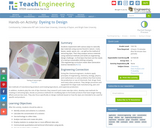
Students experiment with various ways to naturally dye materials using sources found in nature—roots, leaves, seeds, spices, etc.—as well as the method of extracting dyes. Then they analyze various materials using statistical methods and tackle an engineering design challenge—to find dyes that best suit the needs of a startup sustainable clothing company.
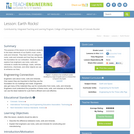
The purpose of this lesson is to introduce students to the basic elements of our Earth's crust: rocks, soils and minerals. They learn how we categorize rocks, soils and minerals and how they are literally the foundation for our civilization. Students also explore how engineers use rocks, soils and minerals to create the buildings, roads, vehicles, electronics, chemicals, and other objects we use to enhance our lives.

In this video produced for Teachers' Domain, Chi-An Wang, a mechanical engineering graduate from the Massachusetts Institute of Technology, describes her process when working with New Balance to design a new triathlon shoe.

This course describes how electronic, optical and magnetic properties of materials originate from their electronic and molecular structure and how these properties can be designed for particular applications. It offers experimental exploration of the electronic, optical and magnetic properties of materials through hands-on experimentation and practical materials examples.
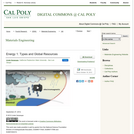
This video defines energy, reviews a model of different types of energy and presents the four known stable global energy resources. This video is part of the Sustainability Learning Suites, made possible in part by a grant from the National Science Foundation. See 'Learn more about this resource' for Learning Objectives and Activities.

This video takes an in-depth look at the annual energy available on earth against the amount of energy used by humans. It uses a graphic, published by Wes Hermann in the journal Energy, to makes clear the different energy fluxes. This video is part of the Sustainability Learning Suites, made possible in part by a grant from the National Science Foundation. See 'Learn more about this resource' for Learning Objectives and Activities.
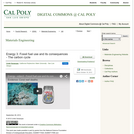
This video goes through the carbon cycle and describes how using fossil fuels threatens the foundation of the aquatic global food chain. This video is part of the Sustainability Learning Suites, made possible in part by a grant from the National Science Foundation. See 'Learn more about this resource' for Learning Objectives and Activities.
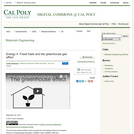
This video describes in detail the greenhouse effect and how recovery from energy from fossile fuels results in green house gases. This video is part of the Sustainability Learning Suites, made possible in part by a grant from the National Science Foundation. See 'Learn more about this resource' for Learning Objectives and Activities.